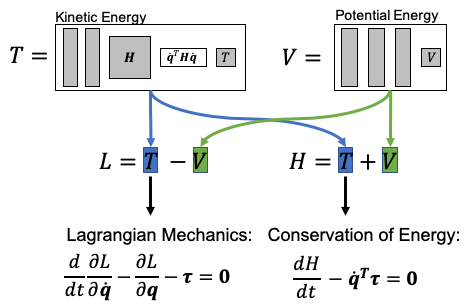The open-source implementation of Deep Lagrangian Networks presented in
Abstract:
Models describing the dynamics of the robot and its environment are essential to achieve precise control as well as
sample-efficient reinforcement learning. Currently, engineers prefer manually engineered models due to the physical
plausibility and robust generalization despite their labor intensive development. To learn models that are physically
plausible and achieve better generalization, we proposed Deep Lagrangian Networks (DeLaN). DeLaN uses the Euler-Lagrange
differential equation from Lagrangian mechanics to derive an optimization objective that guarantees physical plausible models.
Let
Figure 1: The network structure and loss of Deep Lagrangian Networks
Example:
In this example, we apply Deep Lagrangian Networks to a simulated two degree of freedom robot. For training the robots
executes different trajectories resembling characters and records the trajectory as well as motor torques. The recorded
trajectory data is then used to train Deep Lagrangian Networks using Adam. Thereby, DeLaN learns the force decomposition
into inertial, Coriolis & centrifugal and gravitatonal forces unsupervised from the super-imposed torques. The force
decomposition for testing characters not part of the training set is shown in Figure 2. DeLaN learns the true underlying
decomposition and achieves low mean squared error on the test data (Table 1). DeLaN is computationally efficient and
achieves one-step prediction with an average frequency of 1500Hz. Therefore, DeLaN can be used in real-time control applications.
Torque MSE = 4.327e-04
Inertial MSE = 7.338e-04
Coriolis & Centrifugal MSE = 2.227e-04
Gravitational MSE = 7.338e-04
Power Conservation MSE = 4.456e-05
Comp Time per Sample = 6.590e-04s / 1517.4Hz
Table 1: The mean squared error of the learned force decomposition compared to the ground truth decomposition as well as the average computation time per sample on a AMD 3950 CPU.
Figure 2: (a) The torque
Installation:
For installation this python package can be cloned and installed via pip
git clone https://github.com/milutter/deep_lagrangian_networks.git deep_lagrangian_networks
pip install deep_lagrangian_networks
python deep_lagrangian_networks/example_DeLaN.py -r 1
Citation:
If you use this implementation within your paper, please cite:
@inproceedings{lutter2019deep,
author = "Lutter, M. and Ritter, C. and Peters, J.",
year = "2019",
title = "Deep Lagrangian Networks: Using Physics as Model Prior for Deep Learning",
booktitle = "International Conference on Learning Representations (ICLR)",
}
@inproceedings{lutter2019energy,
author = "Lutter, M. and Listmann, K. and Peters, J.",
year = "2019",
title = "Deep Lagrangian Networks for end-to-end learning of energy-based control for under-actuated systems",
booktitle = "International Conference on Intelligent Robots & Systems (IROS)",
}
@article{lutter2021combining,
author = "Lutter, M. abd Peters, P.",
year = "2021",
title = "Combining Physics and Deep Learning to learn Continuous-Time Dynamics Models",
journal = "arXiv preprint arXiv:2110.01894"
}
Contact:
If you have any further questions or suggestions, feel free to reach out to me via
michael AT robot-learning DOT de

